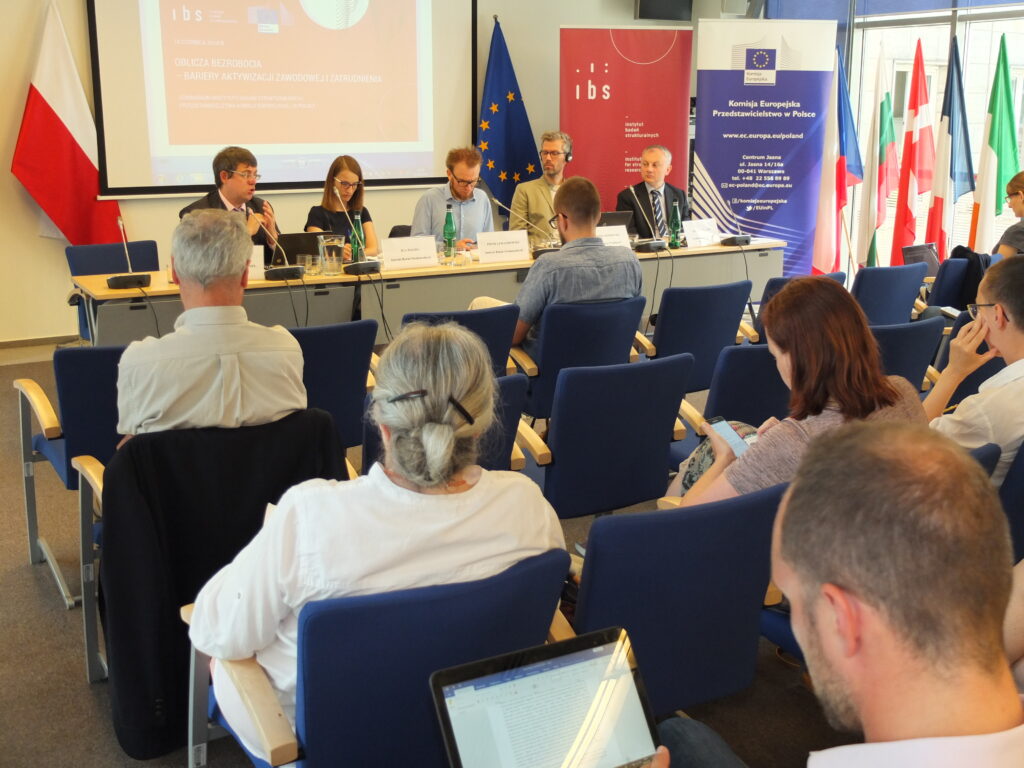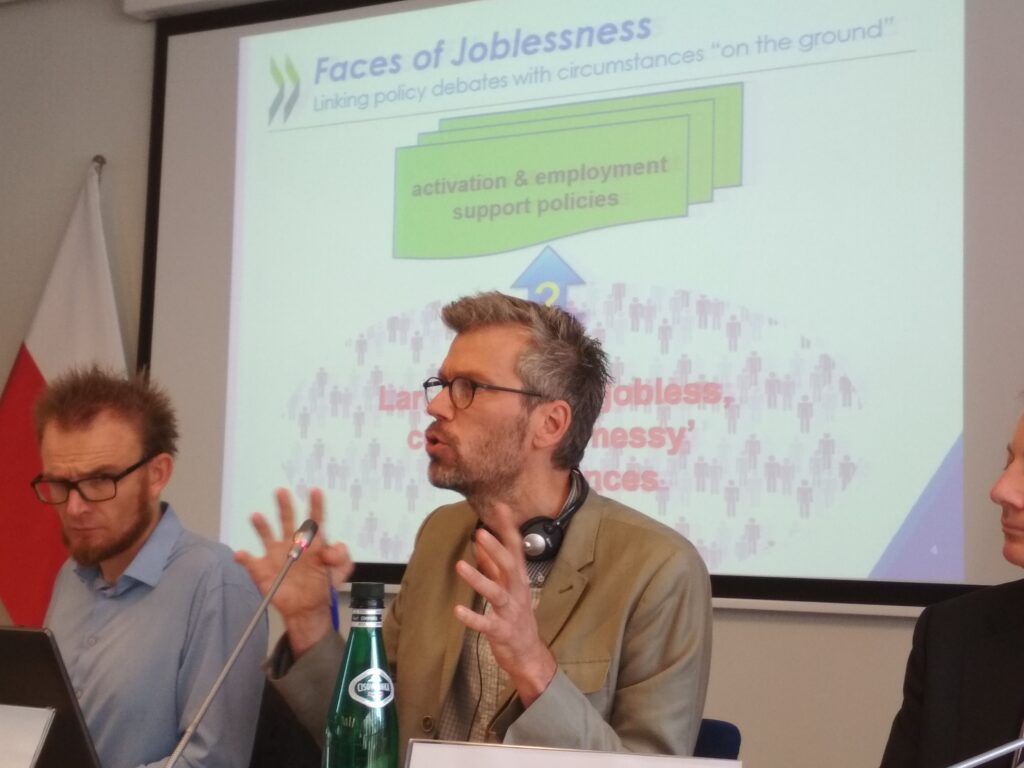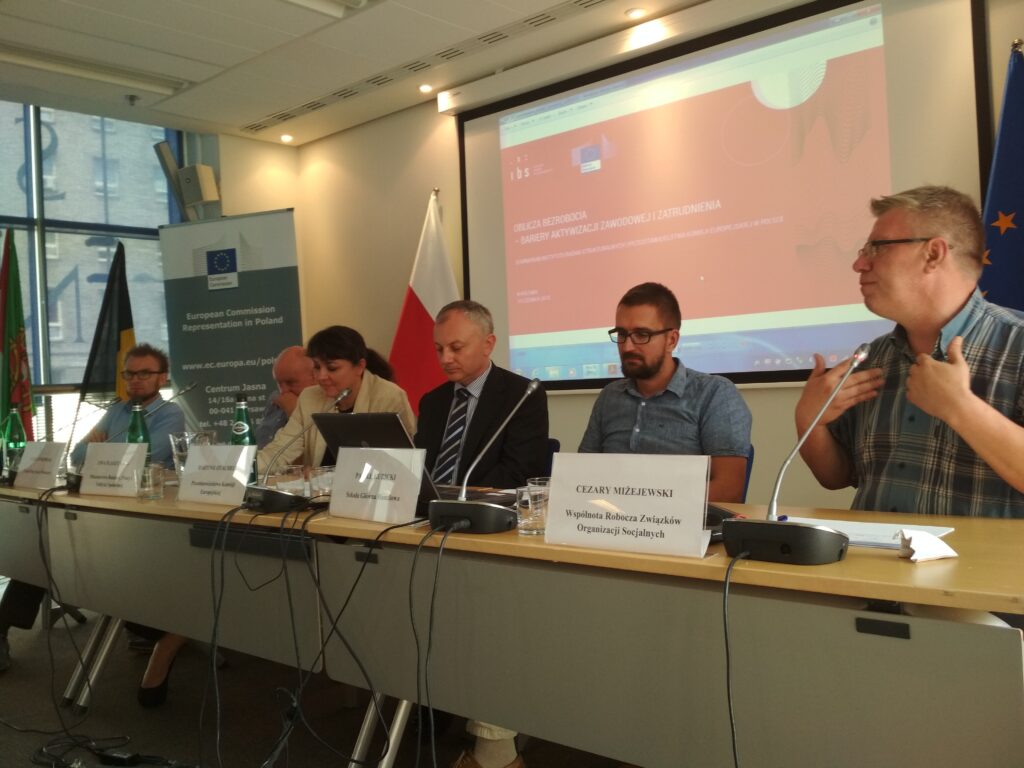During the seminar, we discussed the economic activity of Poles in light of the latest scientific research presented by Herwig Immervoll (OECD), Iga Magda (IBS, Warsaw School of Economics (SGH)), and Paweł Kubicki (SGH). The following experts participated in a panel discussion: Lech Antkowiak (Warsaw Labour Office), Ewa Flaszyńska (Ministry of Family, Labour and Social Policy), Paweł Kubicki (SGH), and Cezary Miżejewski (Working Community of Associations of Social Organisations (WRZOS)). We encourage you to read the presentations and the summary of the seminar.
Challenges for the Polish labour market: the perspective of the European Commission
The situation in the Polish labour market has improved substantially over the past 20 years. Registered unemployment is at its lowest since statistics started being kept. However, there are still over 6 million people in the 20-64 age group who remain jobless.
‘We note the lack of a clear signal from the government that employment is an important issue in Poland’ – Rafał Janas (DG EMPL).
At the beginning of the meeting, Rafał Janas of the Directorate-General for Employment and Social Affairs of the European Commission (DG EMPL) described the main challenges facing the Polish labour market: declining employment rates in some social groups, low participation of women in the labour market, qualifications that are inadequate to meet the needs of the labour market, segmentation of the labour market, and the need to migrate to maintain economic growth. Employment stimulation should be provided for women (of all ages), older workers, as well as disabled people and their caregivers. The agricultural system could be used more effectively: KRUS (the Polish Social Insurance Fund for Farmers) is hindering an increase in mobility in general and occupational mobility in particular.
39% of working-age people in Poland are jobless or employed on a very limited basis
Herwig Immervoll of the Organisation for Economic Cooperation and Development (OECD) showed the joblessness statistics in selected OECD countries. In Poland, 39% of working-age people are jobless or employed on a very limited basis; in Greece, this figure is almost 50%, while in Austria it is less than 25%. Studies conducted together with the World Bank identified three sets of barriers to employment: a work-related capabilities, motivation/incentives, and opportunities in the labour market. In most cases, the lack of work is the result of multiple factors. Instruments aimed at employment stimulation should be tailored to specific groups (→ presentation).
Researchers have described the following groups of the unemployed:
- low-income inactive women: mostly middle-aged, with little work experience
- labour-market inactive mothers: often without any work experience
- young, long-term unemployed women: educated, but with few opportunities in the labour market
- older inactive men: with low skills/on early retirement
- inactive seniors: usually well-educated, but in poor health
What is behind the low level of women labour market participation in Poland?
Iga Magda (IBS, SGH) pointed out that the labour force participation rate of women aged 15-64 in Poland was 62%, which is one of the lowest rates in Europe (the EU28 average is 67%). This is mainly the result of the low level of participation in the labour force of women over 50. Still in 2016 about 1.8 million women aged 20-49 were jobless, which constituted as much as 25% of the women in this age group. Compared to previous years, the percentage of women declaring family and housekeeping duties as the reason for their inactivity had increased.
In studies conducted jointly with Aneta Kiełczewska (IBS), the researchers identified nine groups of women with similar features and reasons for being jobless. Twenty-seven per cent of women aged 20-49 have not taken a job or tried to find one because they are occupied with their education, 18 per cent are taking care of children, while 13 per cent are women with secondary or higher education who have been discouraged by their job search. Different steps should be taken for each group in order to facilitate or motivate them to take up employment, e.g., providing greater work flexibility, making work more profitable (including by reducing the tax wedge on the lowest wages), providing assistance in obtaining qualifications, helping individuals return to the labour market, and providing institutional care for children (→ presentation in Polish).



Labour force participation of the disabled in Poland: 26% in 2017
Paweł Kubicki (SGH) presented the situation regarding the disabled in the labour market in Poland. In March 2018, 260,000 people with disabilities were employed, most of them in the open market. The labour force participation is growing (nearly 29% in 2017), as well is their employment rate (26% in 2017). Over the last 10 years, the breakdown of working people has changed, but the number of people outside the labour market dominates (→presentation in Polish). Paweł Kubicki argued that existing instruments did not allow for a significant improvement in the situation, and that the slight increase in employment was the result of the generally good economic conditions in the labour market. According to Kubicki, the focus should be shifted from supporting family caregivers and employers to disabled people themselves. Krzysztof Kosiński, of the Polish Organisation of Employers of the Disabled (POPON), commented that the labour market was waiting for the disabled and that the problem was their very low rate of employment.
‘Diaries of the Unemployed’ – changes in attitudes towards, and causes of, joblessness
Paweł Kubicki (SGH) also quoted unpublished conclusions of the study ‘Diaries of the Unemployed’ carried out by the Institute of Social Economy of the Warsaw School of Economics. The study, compared to its previous edition of 2003, noted new reasons for unemployment: the lack of work for women shortly after they complete their education, difficulties in finding a job on the part of older women, and being given a lower position after returning from maternity leave. Psychological problems related to continuing unemployment are becoming more frequent. Lech Antkowiak (Warsaw Labour Office) stressed that labour offices had noted the need for psychological help for the unemployed. An example of this might be a successful job support programme for people over 50.
How should employment stimulation and employment policies be shaped?
During the last part of the meeting, Ewa Flaszyńska (Ministry of Family, Labour and Social Policy) talked about the activities of the public administration in support of the employment stimulation. She mentioned a bill regulating the labour market, prepared by the Ministry of Family, Labour and Social Policy, the aim of which is to bring some order to existing regulations.
We will not take advantage of the good situation in the labour market – Lech Antkowiak (Warsaw Labour Office)
‘We are able to provide real assistance only to 8% of the unemployed’, said Lech Antkowiak (Warsaw Labour Office). Assistance provided by labour offices is limited because the funds from the Labour Fund have been reduced by 50%. Cezary Miżejewski (WRZOS) stressed that profitability from work remained low. People behave rationally, so leaving the labour market when the 500+ benefit is available shows that the conditions in the labour market are bad. ‘In Poland, employment flexibility is still associated with the idea of finding a way to make it easier to dismiss an employee.’
During the meeting, participants discussed in particular the mismatch between education and the labour market, as well as how unpopular it is to undertake further education during one’s professional career. The limitations of local labour markets in relation to internal migration constitute another problem. The low employment rate among young people completing their education was also mentioned.
***
Thank you for coming and for your active participation in the meeting!
 H.-Immervoll-A-people-centred-perspective-on-employment-barriers-and-policies-1.pdf
H.-Immervoll-A-people-centred-perspective-on-employment-barriers-and-policies-1.pdf
 IBS_EC_seminar_18.06_agenda_en.pdf
IBS_EC_seminar_18.06_agenda_en.pdf


